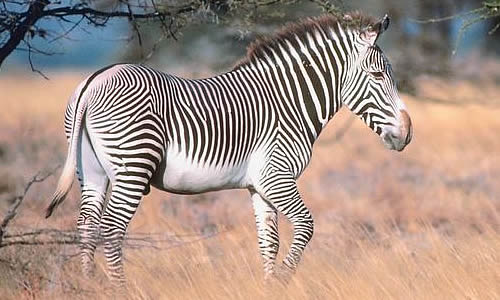Zebras hold a curious appeal. Are they white with black stripes or black with white stripes??? The debate rages whilst these striped beauties offer some of the most rewarding and photogenic photography opportunities in Africa. The Wildebeest and Zebra migration in Tanzania and Kenya is well known, but the second largest Zebra migration takes place in Botswana. The herds are not as large, but the scenery is stunning and diverse – definitely a must do on a safari wish list!
Did you know that there are 3 species of Zebra…… 2 of which are endangered?
The most common in Southern Africa is the Plains or Burchell’s Zebra. They are the most horse-like in appearance and their stripes extend around the belly. Botswana and Etosha Game Reserve in Namibia offer wonderful chances to view these amazing animals in great herds. It is no wonder that the collective noun for Zebra is “Dazzle” for that is what they do!
The Mountain Zebra is found mostly in the Western and Eastern Cape of South Africa and is regarded as an endangered species. Its stripes do not extend around the belly which makes its white belly an easily identifiable feature. One of the best places to see them is in the Mountain Zebra National Park which was created primarily to protect this species. The park is situated in the Eastern Cape near the town of Craddock.
The last of the 3 is the Grevy’s Zebra which is the largest species of zebra. They are listed as endangered and are listed on Appendix I of the Convention on International Trade of Endangered Species of Flora and Fauna (CITES) which offers them the highest protection against illegal trading. Historically, the Grevy’s zebra inhabited the semiarid scrublands and plains of Somalia, Ethiopia, Eritrea, Djibouti, and Kenya in East Africa. However, due to rapid declines in their population, they are now confined to the Horn of Africa, primarily Southern Ethiopia and Northern Kenya. The stripes on the Grevy’s zebra are narrow and close-set, being broader on the neck and extending to the hooves. Grevy’s zebra have one black stripe running down the length of their backs, however, their belly and the area around the base of the tail lack stripes and are just white in colour. They can be seen in Samburu National Park, Kenya.




